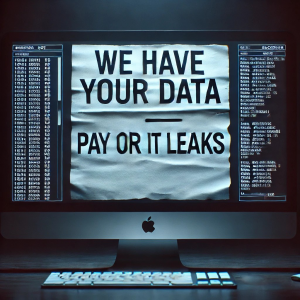
Think ransomware is your worst nightmare? Think again.
Cybercriminals have found a new way to hold businesses hostage – and it may be more ruthless than file encryption. It’s called data extortion, and it’s changing the cybersecurity landscape fast.
Instead of encrypting your files and demanding payment for a decryption key, hackers steal your data and threaten to leak it online unless you pay up. There’s no recovery key, no system to unlock – just the looming threat of a devastating data breach.
In 2024, over 5,400 extortion-based attacks were reported globally – an 11% increase from the previous year (Cyberint). If your business isn’t prepared, the consequences could be severe.
The Rise of Data Extortion: What’s Different?
Unlike traditional ransomware, where encryption locks your files, data extortion is faster, stealthier, and easier to execute.
Here’s how it works:
-
Data Theft: Hackers quietly extract sensitive files – including client data, employee records, financials, and IP.
-
Extortion Threats: Instead of locking systems, they demand payment or threaten to publish your data.
-
No Decryption Needed: Without encryption, attackers avoid traditional detection methods and act more quickly.
If you aren’t using next-generation cybersecurity strategies, your business is already behind. Schedule a discovery call today to learn how to protect your business.
Why Data Extortion Is Even More Dangerous Than Ransomware
Reputation Loss: One leak of sensitive client or employee data could destroy years of brand trust.
Regulatory Fines: Violating laws like GDPR, HIPAA, or PCI DSS can lead to hefty penalties.
Legal Consequences: Victims of leaked data – customers or employees – may sue your business.
Recurring Threats: Hackers can keep copies of your data and extort you again later.
Why Hackers Are Ditching Encryption
Extortion is faster and harder to detect than ransomware. Here's why it's gaining popularity:
-
Fewer Resources Needed: No need to build or deploy ransomware kits.
-
Bypasses Traditional Defenses: Antivirus software and endpoint protection tools typically flag encryption attempts, not data theft.
-
Greater Leverage: Releasing sensitive client info online causes more damage and pressure than locked files.
Need to stay a step ahead? Subscribe to our Cybersecurity Tip of the Week for free weekly advice on emerging threats like this.
Traditional Security Isn’t Enough
Relying on basic antivirus and firewalls leaves your business vulnerable. Hackers today are:
-
Using infostealers to harvest credentials
-
Exploiting cloud storage vulnerabilities
-
Disguising data theft as normal network traffic
To keep up, you need AI-powered protection, endpoint visibility, and real-time monitoring. Learn more on our Network Security services page.
How To Defend Against Data Extortion
✅ Adopt a Zero Trust Model
Assume no one is trustworthy by default. Implement:
-
Role-based access controls
-
Strict identity and access management (IAM)
-
Multifactor authentication (MFA)
✅ Use Advanced Threat Detection & DLP
Deploy tools that detect and block:
-
Unusual data transfers
-
Unauthorized file access
-
Data leaks from cloud environments
✅ Encrypt Sensitive Data
Even if it’s stolen, encrypted data is worthless to hackers.
-
Use end-to-end encryption for all files
-
Secure communication channels
✅ Backup & Disaster Recovery
While backups won’t prevent theft, they help you recover quickly.
-
Maintain offline backups
-
Regularly test your restore process
✅ Train Your Team
Human error is the #1 cause of data breaches.
-
Train employees to identify phishing attempts
-
Reinforce secure access and sharing protocols
Want to know where your vulnerabilities are? Schedule a risk assessment with our team.
Don’t Let Hackers Use Your Data Against You
Data extortion is rising – and traditional defenses won’t cut it. If your systems aren’t secured and your employees aren’t trained, you’re vulnerable.
It’s time to take cybersecurity seriously. Let us help you prepare for what’s coming next.
Click here to schedule your FREE Network Assessment and take the first step toward a stronger, smarter IT strategy.



